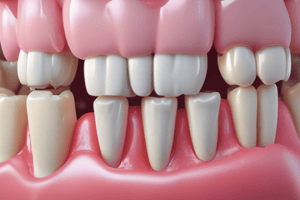Podcast
Questions and Answers
What is the goal of the newsletter 'Cracking the Cracked Tooth Code'?
What is the goal of the newsletter 'Cracking the Cracked Tooth Code'?
The goal is to help general practitioners with diagnosis and treatment planning, and to foster clearer communication between members of the dental team.
What are the diagnostic and treatment challenges related to tooth fractures primarily discussed in the newsletter?
What are the diagnostic and treatment challenges related to tooth fractures primarily discussed in the newsletter?
The newsletter investigates diagnostic and treatment challenges related to tooth fractures primarily in the long axis of the crown and/or root. This includes determining the extent of longitudinal fractures, when a coronal restoration should be placed, when root canal treatment is needed, and when a tooth or root should be extracted based on the location and extent of the fracture.
Why is the term 'longitudinal fracture' used in the context of tooth fractures?
Why is the term 'longitudinal fracture' used in the context of tooth fractures?
The term 'longitudinal fracture' is used because it typically represents vertical extensions of fractures over distance and time. These linear fractures tend to grow and change as opposed to those resulting from impact trauma, leading to problems with diagnosis and treatment.
What are the findings that need to be detected in terms of location and extent according to the text?
What are the findings that need to be detected in terms of location and extent according to the text?
What is considered pathonomonic for the presence of a vertical root fracture (VRF)?
What is considered pathonomonic for the presence of a vertical root fracture (VRF)?
What is the only predictable treatment for a vertical root fracture?
What is the only predictable treatment for a vertical root fracture?
What are the cardinal rules for preventing vertical root fractures?
What are the cardinal rules for preventing vertical root fractures?
What is the classic appearance of a vertical root fracture?
What is the classic appearance of a vertical root fracture?
What are the exclusive bonus materials available in the ENDODONTICS: Colleagues for Excellence newsletter?
What are the exclusive bonus materials available in the ENDODONTICS: Colleagues for Excellence newsletter?
What percentage of cases with crown restoration without root canal treatment required root canal treatment within six months?
What percentage of cases with crown restoration without root canal treatment required root canal treatment within six months?
What is the recommended treatment for split teeth?
What is the recommended treatment for split teeth?
What is a split tooth?
What is a split tooth?
What is a true vertical root fracture?
What is a true vertical root fracture?
What is the prognosis for cracked teeth compared to other longitudinal fractures?
What is the prognosis for cracked teeth compared to other longitudinal fractures?
What is the treatment for extensively cracked teeth?
What is the treatment for extensively cracked teeth?
What are the typical signs and symptoms of patients with vertical root fractures?
What are the typical signs and symptoms of patients with vertical root fractures?
What is the recommended treatment for vertical root fractures?
What is the recommended treatment for vertical root fractures?
What do virtually all vertical root fractures have a history of?
What do virtually all vertical root fractures have a history of?
What may vertical root fractures mimic?
What may vertical root fractures mimic?
What is rare in radiographic evidence for vertical root fractures?
What is rare in radiographic evidence for vertical root fractures?
Where are cases of vertical root fractures often referred for evaluation?
Where are cases of vertical root fractures often referred for evaluation?
Describe the diagnostic clues for cracked tooth treatment plan.
Describe the diagnostic clues for cracked tooth treatment plan.
What is the dependence of root canal treatment in cracked tooth cases?
What is the dependence of root canal treatment in cracked tooth cases?
What can help determine the apical extent of the crack and whether the pulp is involved?
What can help determine the apical extent of the crack and whether the pulp is involved?
What is not usually indicated when dealing with the proximal external surface portion of the tooth below the cement-enamel junction?
What is not usually indicated when dealing with the proximal external surface portion of the tooth below the cement-enamel junction?
What should patients be informed about regarding the prognosis for cracked teeth?
What should patients be informed about regarding the prognosis for cracked teeth?
When is the long-term prognosis for a cracked tooth better?
When is the long-term prognosis for a cracked tooth better?
What is the role of cuspal-reinforced restoration in cracked tooth cases?
What is the role of cuspal-reinforced restoration in cracked tooth cases?
What was the two-year survival rate of root-filled cracked teeth with irreversible pulpitis as determined by a study in 2006?
What was the two-year survival rate of root-filled cracked teeth with irreversible pulpitis as determined by a study in 2006?
How many patients were evaluated in the study from 2007 that focused on teeth diagnosed with reversible pulpitis that had a cracked tooth?
How many patients were evaluated in the study from 2007 that focused on teeth diagnosed with reversible pulpitis that had a cracked tooth?
What is the status of studies outlining successful outcomes for cracked teeth?
What is the status of studies outlining successful outcomes for cracked teeth?
Explain the potential problem associated with having a crack in a tooth.
Explain the potential problem associated with having a crack in a tooth.
What are the five types of longitudinal tooth fractures mentioned in the text?
What are the five types of longitudinal tooth fractures mentioned in the text?
What are the steps for crack detection and confirmation mentioned in the text?
What are the steps for crack detection and confirmation mentioned in the text?
What type of longitudinal tooth fracture affects only the enamel?
What type of longitudinal tooth fracture affects only the enamel?
Why is understanding the epidemiology, prognosis, and treatment modalities of each longitudinal fracture classification essential?
Why is understanding the epidemiology, prognosis, and treatment modalities of each longitudinal fracture classification essential?
What are the characteristic signs and symptoms, and early detection mentioned as crucial for saving teeth with cracks?
What are the characteristic signs and symptoms, and early detection mentioned as crucial for saving teeth with cracks?
What can happen once fractures in teeth extend to and expose the pulp?
What can happen once fractures in teeth extend to and expose the pulp?
What is the definition of a fractured cusp?
What is the definition of a fractured cusp?
How are craze lines commonly mistaken for cracks but can be differentiated?
How are craze lines commonly mistaken for cracks but can be differentiated?
What is the impact of lack of knowledge about the types of fractures?
What is the impact of lack of knowledge about the types of fractures?
What is necessary for a diagnosis when the presence of a crack in a tooth does not provide information on the status of the pulp or periapical tissues?
What is necessary for a diagnosis when the presence of a crack in a tooth does not provide information on the status of the pulp or periapical tissues?
What is crucial for saving teeth with cracks?
What is crucial for saving teeth with cracks?
Flashcards
'Cracking the Cracked Tooth Code' Goal
'Cracking the Cracked Tooth Code' Goal
A newsletter aiding general practitioners in diagnosing and treatment planning for tooth fractures, promoting better communication within dental teams.
Detecting Cracks
Detecting Cracks
Cracks in teeth are critical to identify in terms of both their precise location within the tooth structure and how far they extend.
Pathognomonic Sign of VRF
Pathognomonic Sign of VRF
A sinus tract with a narrow, isolated periodontal pocket around a root canal treated tooth suggests a vertical root fracture (VRF).
Treatment for Vertical Root Fracture
Treatment for Vertical Root Fracture
Signup and view all the flashcards
Cardinal Rules: Preventing VRF
Cardinal Rules: Preventing VRF
Signup and view all the flashcards
Recommended Treatment for Split Teeth
Recommended Treatment for Split Teeth
Signup and view all the flashcards
What is a Split Tooth?
What is a Split Tooth?
Signup and view all the flashcards
Define True Vertical Root Fracture
Define True Vertical Root Fracture
Signup and view all the flashcards
Treatment for Extensively Cracked Teeth
Treatment for Extensively Cracked Teeth
Signup and view all the flashcards
Treatment for Vertical Root Fractures
Treatment for Vertical Root Fractures
Signup and view all the flashcards
Vertical Root Fractures Can Mimic
Vertical Root Fractures Can Mimic
Signup and view all the flashcards
Prognosis for Cracked Teeth?
Prognosis for Cracked Teeth?
Signup and view all the flashcards
Potential Problem: Crack in Tooth
Potential Problem: Crack in Tooth
Signup and view all the flashcards
Five Types of Longitudinal Fractures
Five Types of Longitudinal Fractures
Signup and view all the flashcards
Steps for Crack Detection
Steps for Crack Detection
Signup and view all the flashcards
Craze Lines affect?
Craze Lines affect?
Signup and view all the flashcards
Impact of Lack of Fracture Knowledge
Impact of Lack of Fracture Knowledge
Signup and view all the flashcards
Crack Diagnosis Necessity
Crack Diagnosis Necessity
Signup and view all the flashcards
Crucial Steps for Saving Cracked Teeth
Crucial Steps for Saving Cracked Teeth
Signup and view all the flashcards
Fractures Exposing Pulp Lead To
Fractures Exposing Pulp Lead To
Signup and view all the flashcards
Definition of a Fractured Cusp
Definition of a Fractured Cusp
Signup and view all the flashcards
Study Notes
Understanding and Managing Longitudinal Tooth Fractures
- Presence of a crack in a tooth alone does not provide information on the status of the pulp or periapical tissues; other diagnostic tests are necessary for a diagnosis.
- The major problem with having a crack in a tooth is the potential for bacterial penetration, leading to inflammation and disease.
- Teeth with cracks can be saved if identified and treated early.
- Identifying and classifying cracks, characteristic signs and symptoms, and early detection are crucial for saving teeth with cracks.
- Five types of longitudinal tooth fractures are: Craze Lines, Split Tooth, Fractured Cusp, Vertical Root Fracture, and Cracked Tooth.
- Lack of knowledge about the types of fractures may lead to incorrect diagnosis and inappropriate treatment.
- Understanding the epidemiology, prognosis, and treatment modalities of each longitudinal fracture classification is essential.
- Craze lines affect only the enamel, while other types affect enamel, dentin, and possibly the pulp, and are found most often in posterior teeth.
- Fractures in teeth, once extended to and exposed the pulp, can lead to severe pulp and/or periapical pathosis.
- Steps for crack detection and confirmation include dental history, periodontal probing, radiographic examination, restoration removal, tactile examination, staining, periapical tests, transillumination, bite tests, wedging forces, vitality testing, and surgical assessment.
- Craze lines are commonly mistaken for cracks but can be differentiated by transillumination.
- Fractured cusp is defined as a complete or incomplete fracture initiated from the crown of the tooth and extending subgingivally, usually involving at least two aspects of the cusp and extending to the cervical third of the crown or root.
Studying That Suits You
Use AI to generate personalized quizzes and flashcards to suit your learning preferences.




